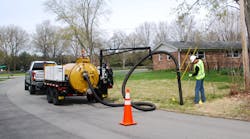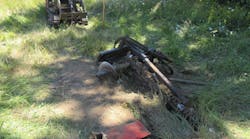Schoharie Reservoir in New York's Catskill mountains supplies much of the 1.3 billion gallons of water used daily by New York City's 8 million residents. From the 2.1 billion-gallons reservoir, water flows through 75 miles of reservoirs, tunnels and aqueducts to reach the city's water distribution facilities.
Impounding the reservoir is the 79-year-old Gilboa dam. In response to an October 2005 study concluding that it did not meet safety standards, owner New York City Department of Environmental Protection launched a $24-million emergency rehabilitation project.
The chief components of the just-completed project were high-capacity anchors to stabilize the dam. On March 6, 2006, Nicholson submitted the low bid for the anchor contract. Nicholson's Mid-Atlantic District Manager Dino Kartofilis oversaw the project.
The DEP gave Nicholson the order to commence work on March 10. The contract called for the installation of 79 anchors: 47 drilled vertically through the dam crest and 32 inclined anchors installed through the dam face from the temporary work platform designed by Nicholson. The anchors range in length from 30.5 meters to 73 meters and have loads between 6,673 kN and 10,231 kN. The largest anchors have 58 strands. Also included in the contract is the installation of four pre-production anchors, dam instrumentation including two extensometers and a data acquisition system, 15 subsurface investigation borings, the replacement of a concrete notch at the top of the dam, and the design and installation of a debris fall protection system.
Nicholson's a team included a construction manager, three superintendents, a quality control manager, a field engineer, five drillers, seven labor foremen, three quality control inspectors, two safety officers, and 35 craftsmen. In addition to a full-time Nicholson employee overseeing quality control, an independent quality control firm was hired to monitor quality during all construction operations at the dam.
Albany, N.Y.-based A. Servidone was responsible for much of the civil work on the project and erected the actual work platforms for Nicholson's drill rigs. Vince Mazzone was their project manager. They also placed the debris protection fence on the dam.
Engineers Gannett Fleming and Hazen and Sawyer joint ventured the design portion of the project.
Nicholson utilized up to three drills to install the vertical anchors on the dam crest and two to three drills for the inclined anchors, which are installed from a 139-meter by 8-meter platform. A total of 5 drill rigs are on-site: three Casagrande C6s, one Casagrande C8, and one Casagrande M9-1. Two cranes, one 2,670 kN and one 1,780 kN, are on-site to service the work on the dam crest and platform. Additional support equipment includes a forklift, excavator, dozer, vacuum truck, two automated grout plants, three generators, and a water treatment plant.
Anchor installation at Gilboa Dam was a lengthy and complex process with approximately 25 individual steps required to construct each anchor. From start to finish, each anchor took roughly four weeks to complete.
To begin the process, a 3-meter-long micropile is installed vertically through the dam and a guide plate is attached on top. The drill rig mast is attached to the guide plate in order to maintain stability and meet the strict anchor drill tolerances of 1:50 for the 45-degree inclined holes while drilling through the steel and boulders that make up this cyclopean dam.
Using a down-the-hole hammer (DTH), a 15-cm by 3-m long pilot hole is drilled for the recess. Another DTH is used to "open" the diameter of the pilot hole from 15 cm to 40 cm, and then an eccentric DTH increases the hole diameter to 122 cm. A rebar cage and trumpet pipe are inserted into the recess hole, which is then filled with concrete. Next, a guide sleeve is installed in the trumpet and a 15-cm hole is then drilled with a DTH to the final tip elevation. Another DTH then increases the hole diameter to 38 cm.
After drilling the hole, it is tested for alignment and for water tightness. An alignment survey of the hole is completed with an electronic inclinometer, and the hole is surveyed with a video camera. The hole is then water tested at three different levels using a pneumatic packer: the bond zone, the foundation interface and the dam interior. Due to the extremely fractured rock under the dam, all the inclined holes failed the initial water tightness test.
Meanwhile on-site, two pieces of 36-cm diameter HDPE corrugated and smooth sheathing are "fusion" welded, tremie tubes and spacers are attached to the sheathing, and the system is water tested. Once complete, the crane lifts the sheathing into the hole and the sheathing is water tested a second time.
Back on the dam, the anchor head steel bearing plate is installed on top of the trumpet. These plates are up to 1 meter in diameter and 15-cm thick. The tendon is lifted by the crane and placed through the plate and inside the sheathing. The sheathing is then water tested for a third and final time, and the anchor is grouted both inside and outside the sheathing simultaneously using two grout pumps equipped with flow meters. After the grout has reached a strength of 28 MPa, typically in three to five days, each of the 58 strands is individually stressed to an "alignment load" with a mono-strand jack. A large 15,000-kN center hole jack is then used to stress the entire tendon to a test load of 12,100 kN.
Once the test is completed, the anchor is locked off at its design load and the "stressing tail" of each strand is cut off. All exposed anchorage steel is coated with a bitumastic paste. The top of the recess hole is filled with concrete.
During the anchor installation process, Nicholson captured, treated and disposed of all drill spoil. Over 8,000 tons of solid cuttings have been produced and hauled off-site. In addition millions of liters of water have been treated.
The threat of flooding had been a constant concern during the project. Servidone cut a 5-foot by 220-foot safety notch on the west end of the dam to keep excess water away from Nicholson while working on the remainder of the dam. Although it was capable of channeling up to 3 inches of rain in a 24-hour period, at one point Nicholson had to completely demobilize on June 23rd. On June 28th water rose over the dam's crest and flooded the work area, causing a three-week delay in the work.
In summarizing the mammoth effort achieved on the fast-track schedule they were given, Kartofilis remarked: "This definitely isn't the kind of job you do everyday."




